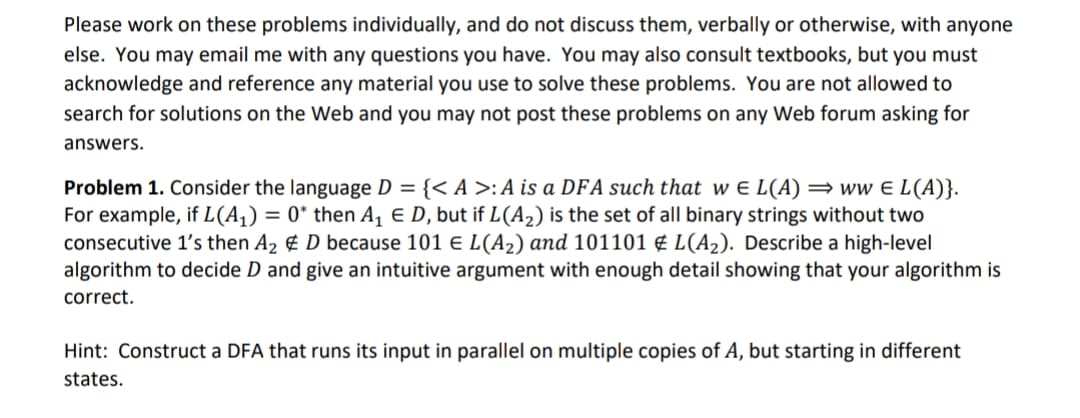Hint: Construct a DFA that runs its input in parallel on multiple copies of A, but starting in different states.
Hint: Construct a DFA that runs its input in parallel on multiple copies of A, but starting in different states.
Computer Networking: A Top-Down Approach (7th Edition)
7th Edition
ISBN:9780133594140
Author:James Kurose, Keith Ross
Publisher:James Kurose, Keith Ross
Chapter1: Computer Networks And The Internet
Section: Chapter Questions
Problem R1RQ: What is the difference between a host and an end system? List several different types of end...
Related questions
Question

Transcribed Image Text:Please work on these problems individually, and do not discuss them, verbally or otherwise, with anyone
else. You may email me with any questions you have. You may also consult textbooks, but you must
acknowledge and reference any material you use to solve these problems. You are not allowed to
search for solutions on the Web and you may not post these problems on any Web forum asking for
answers.
Problem 1. Consider the language D = {< A >:A is a DFA such that w e L(A) =ww e L(A)}.
For example, if L(A,) = 0* then A, E D, but if L(A2) is the set of all binary strings without two
consecutive 1's then A2 ¢ D because 101 e L(A2) and 101101 ¢ L(A2). Describe a high-level
algorithm to decide D and give an intuitive argument with enough detail showing that your algorithm is
correct.
Hint: Construct a DFA that runs its input in parallel on multiple copies of A, but starting in different
states.
Expert Solution
This question has been solved!
Explore an expertly crafted, step-by-step solution for a thorough understanding of key concepts.
This is a popular solution!
Trending now
This is a popular solution!
Step by step
Solved in 2 steps

Recommended textbooks for you

Computer Networking: A Top-Down Approach (7th Edi…
Computer Engineering
ISBN:
9780133594140
Author:
James Kurose, Keith Ross
Publisher:
PEARSON

Computer Organization and Design MIPS Edition, Fi…
Computer Engineering
ISBN:
9780124077263
Author:
David A. Patterson, John L. Hennessy
Publisher:
Elsevier Science

Network+ Guide to Networks (MindTap Course List)
Computer Engineering
ISBN:
9781337569330
Author:
Jill West, Tamara Dean, Jean Andrews
Publisher:
Cengage Learning

Computer Networking: A Top-Down Approach (7th Edi…
Computer Engineering
ISBN:
9780133594140
Author:
James Kurose, Keith Ross
Publisher:
PEARSON

Computer Organization and Design MIPS Edition, Fi…
Computer Engineering
ISBN:
9780124077263
Author:
David A. Patterson, John L. Hennessy
Publisher:
Elsevier Science

Network+ Guide to Networks (MindTap Course List)
Computer Engineering
ISBN:
9781337569330
Author:
Jill West, Tamara Dean, Jean Andrews
Publisher:
Cengage Learning

Concepts of Database Management
Computer Engineering
ISBN:
9781337093422
Author:
Joy L. Starks, Philip J. Pratt, Mary Z. Last
Publisher:
Cengage Learning

Prelude to Programming
Computer Engineering
ISBN:
9780133750423
Author:
VENIT, Stewart
Publisher:
Pearson Education

Sc Business Data Communications and Networking, T…
Computer Engineering
ISBN:
9781119368830
Author:
FITZGERALD
Publisher:
WILEY